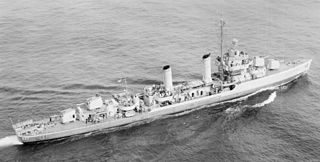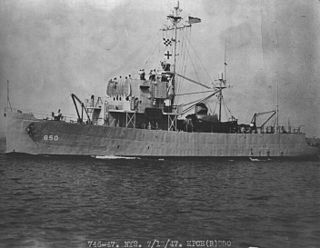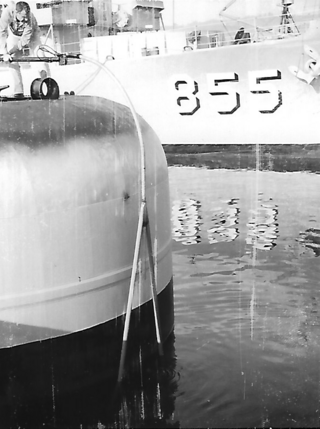The United States Navy, United States Coast Guard, and United States National Oceanic and Atmospheric Administration (NOAA) use a hull classification symbol to identify their ships by type and by individual ship within a type. The system is analogous to the pennant number system that the Royal Navy and other European and Commonwealth navies use.

USS Underhill (DE-682) was a Buckley-class destroyer escort of the United States Navy during World War II. Built in 1943, she served in the Atlantic, the Mediterranean, and the Pacific until her sinking in a suicide attack by a Japanese Kaiten manned torpedo on 24 July 1945.

USS Thorn (DD-647), a Gleaves-class destroyer, was the first ship of the United States Navy to be named for Jonathan Thorn.

USS Sims (DE-154/APD-50) was a Buckley-class destroyer escort in service with the United States Navy from 1943 to 1946. She was scrapped in 1961.
USS Execute (AM-232) was an Admirable-class minesweeper built for the United States Navy during World War II. She was originally ordered and laid down as USS PCE-905, the lead ship of the PCE-905 class of patrol craft. She was reclassified as an Admirable-class minesweeper by the time of her June 1944 launch, and named Execute by the time of her November 1944 commissioning. After service in the Pacific during World War II, she was decommissioned in August 1946 and placed in reserve. While she remained in reserve, Execute was reclassified as MSF-232 in February 1955 but never reactivated. In 1962, she was sold to the Mexican Navy and renamed ARM DM-03. In 1994, she was renamed ARM General Juan N. Méndez (C51). She was stricken in July 2001, but her ultimate fate is not reported in secondary sources.
USS Carlson (BDE-9/DE-9) was an Evarts-class short-hull destroyer escort in the United States Navy. It was named after Chief Machinist's Mate Daniel William Carlson (1899–1942), who was killed during the Battle of Midway aboard the destroyer USS Hammann. The ship was launched and commissioned in 1943. Carlson was assigned to the Pacific fleet during World War II and spent time as a convoy escort and took part in the Battle of Iwo Jima. At the end of the war in 1945 Carlson was decommissioned and the ship was sold the following year.

USS Oberrender (DE-344) was a John C. Butler–class destroyer escort built for the United States Navy during World War II. She was named for Lieutenant Commander Thomas Olin Oberrender Jr., the engineering officer of the light cruiser USS Juneau, who was killed when that ship was torpedoed and sunk during the Naval Battle of Guadalcanal in 1942.

USS Bering Strait (AVP-34) was a United States Navy Barnegat-class small seaplane tender in commission from 1944 to 1946. She tended seaplanes during World War II in the Pacific in combat areas and earned three battle stars by war's end.

BRP Miguel Malvar (PS-19) is the lead ship of the Miguel Malvar class of corvettes of the Philippine Navy. She was originally built as USS Brattleboro PCE(R)-852, a PCE(R)-848-class rescue patrol craft escort for the United States Navy during World War II. In 1966 she was transferred to South Vietnam for service in the Republic of Vietnam Navy as RVNS Ngọc Hồi (HQ-12). She was acquired by the Philippine Navy in April 1976 and later on commissioned as Miguel Malvar after Miguel Malvar y Carpio. The ship is in active service. Along with other World War II-era ships of the Philippine Navy, Miguel Malvar is one of the oldest active fighting ships in the world today.

BRP Sultan Kudarat (PS-22) was a Miguel Malvar-class corvette of the Philippine Navy. It was originally built as USS PCE-881, a PCE-842-class patrol craft for the United States Navy during World War II. In 1961 it was transferred to South Vietnam for service in the Republic of Vietnam Navy as RVNS Đống Đa II (HQ-07). It was acquired by the Philippine Navy on April 1976, and was commissioned later on as RPS Sultan Kudarat (PS-22). Along with other World War II-era ships of the Philippine Navy, Sultan Kudarat was considered one of the oldest active fighting ships in the world, until its retirement in July 5, 2019.
BRP Datu Marikudo (PS-23) was a Malvar-class corvette of the Philippine Navy. She was originally built as USS PCE(R)-853, a PCE(R)-848-class patrol craft for the United States Navy during World War II. She was renamed USS Amherst on 15 February 1956, namesake of both Amherst, Massachusetts and Amherst, Ohio. In February 1970, Amherst was decommissioned and transferred to South Vietnam for service in the Republic of Vietnam Navy as RVNS Vạn Kiếp II (HQ-14). She remained in South Vietnamese service until the collapse of that country in 1975. Vạn Kiếp II was one of several ships that fled from South Vietnam to the Philippines. She was then commissioned into the Philippine Navy on 5 April 1976 and named in honor of Datu Marikudo. Along with other World War II-era ships of the Philippine Navy, Datu Marikudo was considered one of the oldest active fighting ships in the world until her decommissioning.

BRP Cebu (PS-28) was a Miguel Malvar-class corvette of the Philippine Navy. She was originally built as USS PCE-881, a PCE-842-class patrol craft for the United States Navy during World War II and patrolled the Alaskan coast during that war. She was decommissioned from the U.S. Navy and transferred to the Philippine Navy in July 1948 and renamed RPS Cebu (E-28) after the Philippine province of the same name. The ship was decommissioned on 1 October 2019. Along with other World War II-era ships of the Philippine Navy, Cebu was considered one of the world's oldest fighting ships during her active service.
RPS Leyte (PS-30) was a Miguel Malvar-class corvette of the Philippine Navy. She was originally built as USS PCE-885, a PCE-842-class patrol craft for the United States Navy during World War II. She was decommissioned from the U.S. Navy and transferred to the Philippine Navy in July 1948 and renamed Leyte. The ship was decommissioned from the Philippine Navy in 1979 after she ran aground and was damaged beyond repair.

USS Ringness (APD-100) was a Crosley-class high speed transport that served in the United States Navy from 1944 to 1946. After spending 29 years in reserve, she was sold for scrapping in 1975.

The second USS Barataria (AVP-33) was a United States Navy Barnegat-class seaplane tender in commission from 1944 to 1946. She saw service in the later stages of World War II and was decommissioned postwar. She then was transferred to the United States Coast Guard and was in commission as the Coast Guard cutter USCGC Barataria (WAVP-381), later WHEC-381 from 1949 to 1969, serving in the Cuban Missile Crisis and the Vietnam War during her lengthy Coast Guard career.

USS Fairview was a United States Navy PCE(R)-848-class Patrol Craft Escort (Rescue), in commission from April 1944 to May 1968. It was named after Fairview, New Jersey. The ship was present at the surrender of Japan in Tokyo Bay at the end of World War II.

The PCE-842-class patrol craft escort was a United States Navy (USN) ship class of submarine chasers designed during World War II. The PCE-842-class were the only vessels ever designated by the USN as the 'patrol craft escort' (PCE) type. The PCE design was derived from the 180-foot (55 m) Admirable-class minesweeper to complement the 173-foot (53 m) PC-461-class submarine chasers that were used for anti-submarine warfare (ASW) in coastal areas. At 185 feet long and 640 tons, the PCE is more than twice the displacement of the PC but with a less powerful engine also much slower; however, because of its larger size, the PCE was able to undertake longer-range tasks over PC-461-class vessels. The USN envisaged the PCE as enabling PCs and smaller vessels to undertake coastal patrols without being called-upon as often to perform open ocean and convoy escort duties, while simultaneously freeing-up some larger vessels - such as destroyer escorts and destroyers - from convoy ASW duties. The PCE-482-class had a standard crew complement of 99 officers and men. The class would ultimately see 68 total vessels built, serving with multiple navies around the world.

USS Rexburg was built as a PCE(R)-848-class rescue escort patrol craft for the United States Navy during World War II. She was unnamed until 1956. After working through the 1950s and 60s as an oceanographic research vessel for the Navy Electronics Laboratory, Rexburg was decommissioned in 1970 and sold to the Church of Scientology as MV Excaliber.

USS Havre was a United States Navy PCE-842-class patrol craft escort in commission from 14 February 1944 to 1 July 1970. She served in the Central Pacific during World War II, supporting invasions of Battle of Iwo Jima and the Battle of Okinawa, and was present in Tokyo Bay for the formal Surrender of Japan on 2 September 1945. Unlike other ships from this class, which were scrapped or sold to other nations, the vessel stayed the property of the United States Navy, which transferred ownership to the United States Navy Reserve as Naval Reserve Training Ship for 9th Naval District (Chicago) in April 1954. She was renamed USS Havre (PCE-877) on 15 February 1956 as part of a Navy-wide initiative to provide names to all numbered ships. Havre served on the Great Lakes until struck from Navy List on 1 July 1970.

USS Somersworth was a United States Navy PCE(R)-848-class Patrol Craft Escort (Rescue), in commission from April 1944 to September 1965. The ship was named after the city of Somersworth, New Hampshire.
















